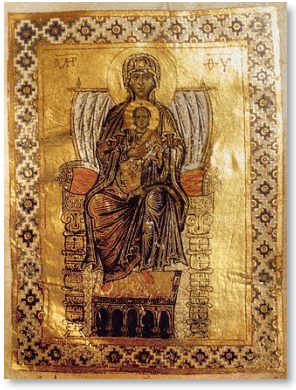The Mother of God and Our Salvation
The modern world is very accustomed to thinking about famous people. We have a virtual cult of personality surrounding sports stars, actors, and politicians. We focus on their character, history, worldview, and achievements. This same mindset often occupies those who come to the Orthodox faith and see its treatment of the Virgin Mary, and in fact all the saints. In truth, we know very little about the Virgin Mary’s background. The Church’s liturgical cycle has incorporated traditional material from outside the gospels that gives an indication of her childhood. However, the focus of these stories is not on her personality so much as on her role within Christ’s work of salvation. That she is considered essential in that work requires that we broaden our understanding of the full nature of salvation itself.
One of the earliest confessions of Christian faith is found in St. Paul’s first letter to the Corinthians. He describes the confession as “tradition” that has been handed down to him, “For I delivered to you first of all that which I also received: that Christ died for our sins according to the Scriptures…” (1 Cor 15:3). It is a phrase so familiar that it is easily overlooked. That Christ “died for our sins” immediately asks, “How?” It is the core question of our salvation and the overriding concern of all of the Church’s teaching. The narrative of how our salvation was accomplished in Christ applies to all of the Church’s doctrines concerning the Virgin Mary. These teachings are not about Mary so much as they are about salvation itself.
These teachings are not about Mary so much as they are about salvation itself.
If we look at the great ecumenical councils of the Church, their concerns center on salvation itself. The language regarding the Trinity, or the two natures of Christ and such, are not matters of abstraction. They were not trying to create a special vocabulary for doing theology. Instead, they sought language that would give expression to the character and nature of salvation itself. What they gave us was the language of communion.
St. Irenaeus, writing in the 2nd century, used a phrase that would be repeated many times in the writings of the early Church. He wrote, “God became man so that man could become god.”1 This is a description of that reality of communion by which we are saved. God made us in His image and then became one of us without giving up His divinity. Thus, He joined us to Himself so that we would have the life of God in us. To be “saved” then is to live the life of God—to live in accordance with the image in which we were created.
The first aspect of this saving communion is accomplished in the event known as the Annunciation, the announcement by the Archangel Gabriel to Mary that she was to become the mother of the Messiah, God’s Son (Luke 1:26–38). St. Luke records that Gabriel was sent to Mary and informed her that she had found favor with God. He announced that she would conceive and bring forth a son named Jesus, who would be “Son of the Highest”, who would reign over the house of Jacob forever, and whose kingdom would never end. Most incredibly, she was told that He who was to be born would be conceived by the Holy Spirit and not a man and called “the Son of God.” We honor Mary because of her great virtue but also because she said “yes” to God.
The Nicene Creed summarizes this event with the simple words: “who for us men and for our salvation came down from heaven and was incarnate of the Holy Spirit and the Virgin Mary and became man.”2 In saying that He was “incarnate”, we are told that God did not merely appear in Mary’s womb, or “borrow” her womb for His use. Rather, He “took flesh” of the Virgin Mary. In other words, He was (and is) “bone of her bone and flesh of her flesh“ (Gen 2:23). It was our humanity, in the womb of the Virgin, that was united to God. “God became what we are.”3
Thus, first and foremost, the Church’s honoring of Mary celebrates and remembers that what took place in her was the beginning of our salvation. In the event of the Annunciation, we see that she is a full participant in that work. God’s intention is made known to her, with an explanation and answer given to her question. Her response, “Behold the maidservant of the Lord! Let it be to me according to your word. (Luke 1:38)” is an act of profound self-emptying and humility before God. It is an action that is often, in the writings of the Church, contrasted with the disobedience of Eve (Gen 3:6).
This event teaches us that our salvation, utterly impossible apart from God, is also not possible apart from human cooperation. Our salvation is wrought in the incarnation of Christ, in which God united Himself with our human nature. Jesus is fully God and fully man and acts as both in the world. Mary’s participation in that unique and essential event is utterly integral to its fulfillment. She cooperates in her will and in her very flesh. As such, she cannot be set aside as somehow inconsequential. In the mind of the Church, to set Mary aside would be to set the humanity of Christ aside.